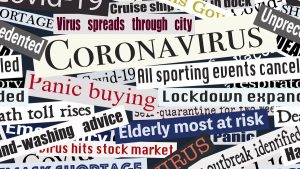Analyzing the events of the 1918 Influenza Pandemic while living through the COVID-19 Pandemic is nothing short of eerie. And perhaps more disturbing than the tragic and personal accounts of the pandemic are the repeated warnings issued by public health officials throughout the beginning of the 21st century. As immunologist Dr. Terrence M. Tumpey and microbiologist Dr. Jessica A. Belser warned in 2018, “influenza viruses are moving targets, and a pandemic virus could nevertheless emerge with as little warning in 2018 as in 1918,” (Belser and Tumpey 2018, 255). Furthermore, as author and historian John M. Barry claimed in 2017 that, “today we worry about Ebola or Zika or MERS or other exotic pathogens, not a disease often confused with the common cold. This is a mistake. We are arguably as vulnerable – or more vulnerable – to another pandemic as we were in 1918,” (Barry 2017, 36). These were not the only warnings to have circulated in the scientific community throughout the past decade, as if magically aware of the realities of 2020. However, the predictions of scientists and historians were far from magic; they were based on a century’s worth of research following the 1918 Influenza Pandemic. And COVID-19, the disease currently ravaging the globe and spreading across the United States every day, is unfortunate proof that we were not, in fact, prepared for pandemics.
COVID-19, officially known as severe acute respiratory syndrome coronavirus 2, or SARS-CoV-2,

Image credits: Vox
originated in Wuhan, China, and rapidly made its way around the globe, infecting over 75 million people worldwide and killing 1,680,000 as of December 20th, 2020 (World Health Organization Coronavirus Dashboard). Although there are notable differences between the current-day pandemic and the Influenza Pandemic of 1918, as an NCBI report published in May detailed, “to face this epidemic we are not in a different situation than in another period of our history when we had to manage the Spanish flu during the first world war. We do not know this virus, the characteristics of its disease, which drugs might give relief to patients and we do not have a vaccine. In other words, we do not have anything, we are in the same situation as during the other outbreaks,” (Franchini et al. 2020, 245). Despite the vaccine progress made in the 7 months since this report’s publication, much of the sentiment holds true. Furthermore, much of the chaos in the global response to COVID-19 was eerily foreshadowed by the 1918 Influenza Pandemic.
One lesson to be extracted from studying the Influenza Pandemic of 1918 is, in the words of Barry, “to tell the truth,” (Barry 2017, 43). He goes on to articulate that although “that idea is incorporated into every preparedness plan I know of, its actual implementation will depend on the character and leadership of the people in charge when a crisis erupts,” (Barry 2017, 43). The importance of truth in pandemic preparedness has become increasingly apparent, especially with regard to the United States’ response to this disaster. Instead of encouraging safety protocols and spreading scientific fact, “U.S. President Donald J. Trump accused the World Health Organization (WHO) of being slow to warn the world about the real threat level and for being an apologist for China,” while simultaneously attempting to minimize the impacts of COVID-19 on a global scale (Caballero-Anthony 2020, 42). The politicization of the pandemic is certainly not unique to the United States, however, the issue of truth is highly reminiscent of the war-time censorship of 1918.

Image credits: The Washington Post
Furthermore, the 1918 Pandemic emphasized the sheer threat to national strength and security posed by infectious disease. While it was certainly known that the 1918 Influenza Pandemic ultimately killed more people across the globe than World War I, the true potential for pandemic damage had largely been ignored up until COVID. As a report by the Council on Foreign Relations described, the COVID-19 pandemic “is also a reminder that health security is critical to national security, and that countries with weak health systems are poorly equipped to mount a strong defense against the massive onslaught of an unseen enemy. Pouring funds into building up sophisticated military surveillance capabilities is no match for and of little value to the much-needed global and national diseases surveillance systems that can prevent, detect, trace, and respond to a rapidly spreading virus with lethal potency,” (Caballero-Anthony 2020, 42). Despite the devastation caused by the Influenza Pandemic, resources were never properly allocated to ensure preparedness for this new, 21st century, pandemic.
In light of the tragic state of the world, there is something infuriating about analyzing the lessons that could have, and, many would argue, should have been learned from 1918 – and these lessons are far more plentiful than this page could describe. As public health consultant John Ashton wrote in a report for the Journal of the Royal Society of Medicine, “the cliché that if you don’t learn the lessons of history you are destined to repeat the same mistakes rings especially true today,” (Ashton 2020, 198). However, as society navigates the tragic and brutal SARS-CoV-2 Pandemic, turning to the history of 1918 for guidance, this pandemic could mark a turning point in global pandemic preparedness. And, hopefully, the lessons of COVID-19 will not be similarly overlooked.